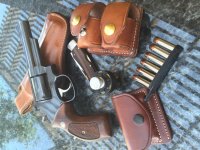I’m a beginner looking to get my first gun for self-defense/home protection. I doubt I’d ever carry it anywhere, it’s more to have at home on the nightstand in case a psycho breaks in. I’m a woman with fairly small hands but I’m not weak. I’m interested in a revolver because I’ve been told and read about it’s easy maintenance and less likely to malfunction. First I was looking at the small compact ones but was reading that recoil was unbearable on those for some. I need something I can take to the range and learn with and I don’t want hard recoil or a trigger that’ll hurt my finger. It also needs to be light/manageable enough that in the middle of the night if I need it I can just grab it and go. I’d be using .38 special + p. I was looking at the s&w 67 vs the 19 performance center one. Which one out of these two would be best for a beginner with least recoil, easiest to handle, smoothest trigger and easy maintenance? Thanks!
67
.38
4”/9.4” overall
36 oz
19 pro
3”/8.0”
34.1 oz
67
.38
4”/9.4” overall
36 oz
19 pro
3”/8.0”
34.1 oz
Last edited:


